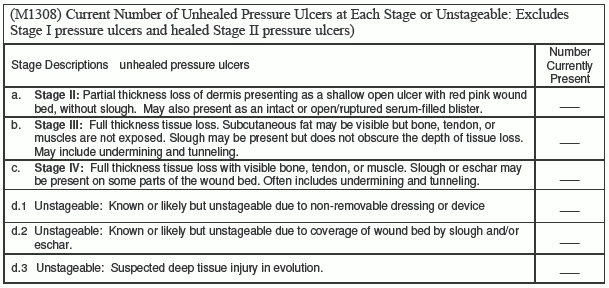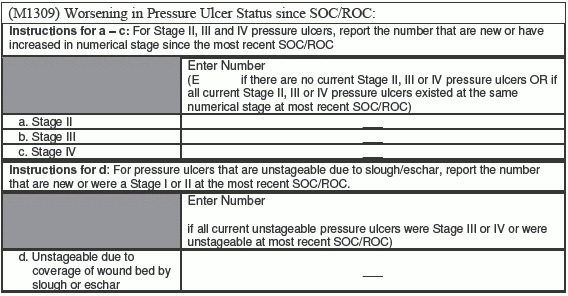Prepare for Pressure Ulcer Changes in OASIS-C1
Say goodbye to your old M1308 headaches.
The OASIS integumentary items are some of the trickiest to answer correctly. But when the OASIS-C1 debuts some of the bumps in the road to OASIS accuracy will be smoothed out with changes to these wound items.
“The wound questions are always the most problematic in the OASIS,” said Judy Adams, RN, BSN, HCS-D, HCS-O, with Adams Home Care Consulting in Asheville, N.C. “The changes [in OASIS-C1] should help.”
Welcome these Wording Changes
Several items in OASIS-C1 have minor wording changes that will help make the items easier to interpret. In the integumentary section, the re-worded items include:
Look for a Whole New M1308
Perhaps the most anticipated change to the assessment tool is the OASIS-C1’s revamp of M1308: Current Number of Unhealed (non epithelialized) Pressure Ulcers at Each Stage. The first thing you’ll notice about the new M1308 is the item title that reads “Current Number of Unhealed Pressure Ulcers at Each Stage or Unstageable.” You’ll complete M1308 at the start of care (SOC), resumption of care (ROC), follow-up, and discharge time points.
The biggest change in M1308 is reducing this item from two columns to one.
Confusing: In OASIS-C, you complete M1308’s Column 2 at follow-up and discharge to show the number of current pressure ulcers listed in Column 1 that were present at the most recent SOC and ROC. Completing this second column accurately is tricky, so it’s welcome news that it’s been deleted in OASIS C-1.
Add a New Pressure Ulcer Item
As you say goodbye to M1308 Column 2, get ready to greet M1309: Worsening in Pressure Ulcer Status since SOC/ROC. Here, you’ll indicate the number of current pressure ulcers that were not present or were a lesser stage at the most recent SOC/ROC, Adams said. You’ll complete this item at discharge only. This new item replaces the second column of M1308.
This new item allows you to record pressure ulcers that are unstageable due to coverage of the wound bed by slough or eschar. You’ll also be able to report new pressure ulcers or those that were previously Stage I or Stage II at the most recent SOC or ROC.
M1309 “shows if pressure ulcers are worsening,” Adams said. “This will be a clearer picture of worsening pressure ulcers.”
“The elimination of the second column of M1308 and the addition of M1309 updates were developed to have greater harmonization of wording with other post-acute data collection instruments,” Adam said.
Note: To order a CD or transcript of Adams’ audioconference, visit www.audioeducator.com/home-health/oasis-c-1-2014-01-22-14.html.



